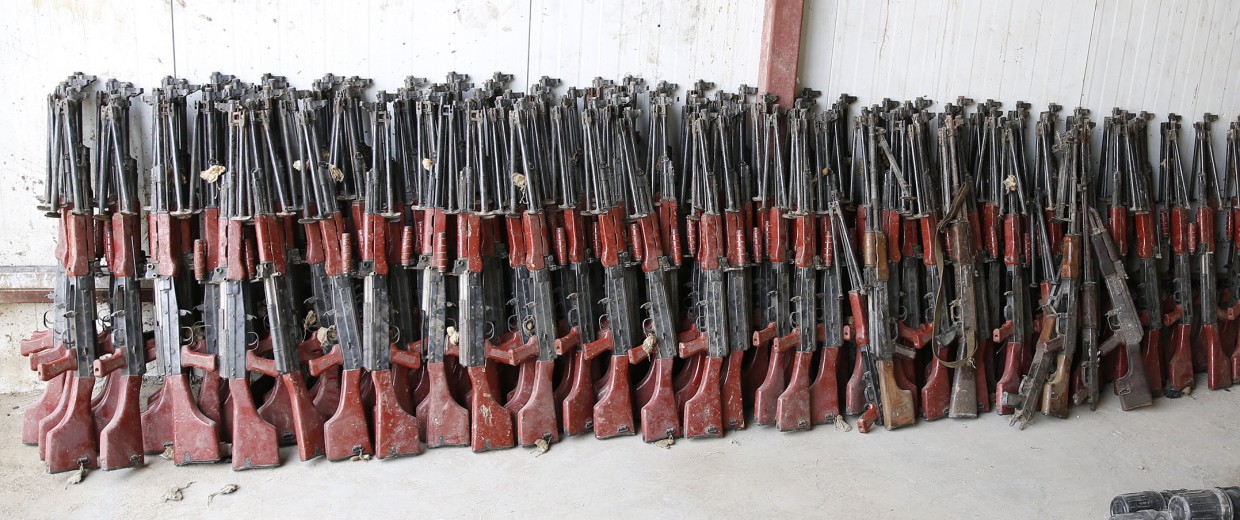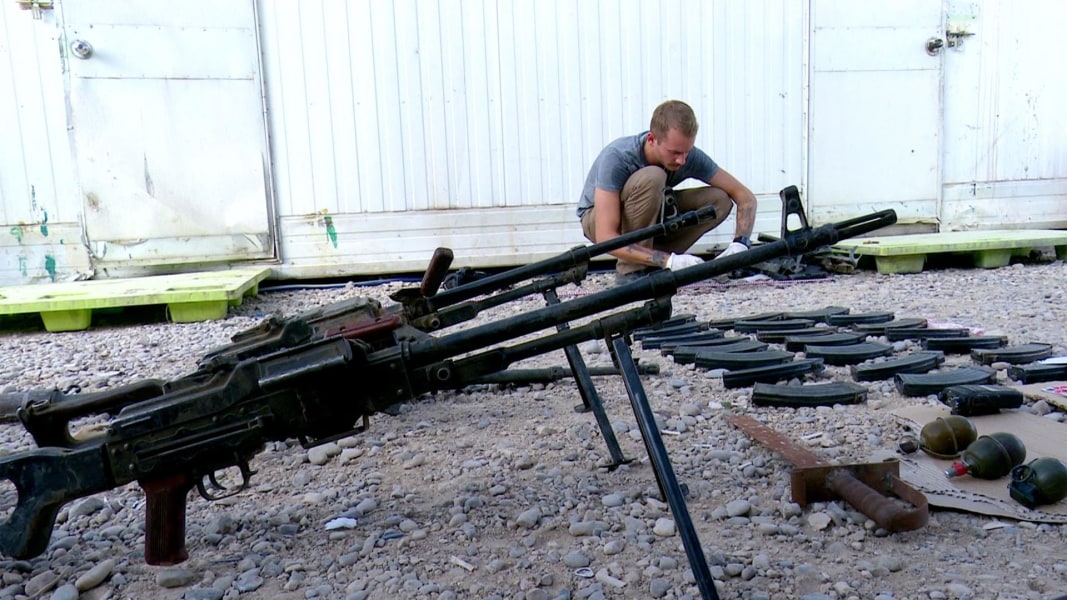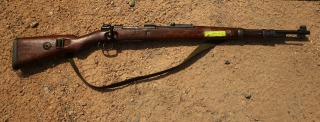
These 122 Chinese light machine guns were recovered from an ISIS site south of Mosul, Iraq. At least one pouch of amphetamine was attached to each.
LONDON — Some weapons bought by the U.S. military in 2015 ended up in the hands of Islamic State fighters within two months, according to a report released Thursday.
The findings, by Conflict Armament Research (CAR), an independent arms-tracking organization, are based on three years of meticulous documentation of weapons recovered from ISIS on the battlefields of Iraq and Syria.
CAR used serial numbers or key markings on the weapons to trace them back to their origin and try to piece together how they were obtained by the militants.
Some of the weapons found on the front lines after ISIS was driven out also include Chinese-manufactured machine guns laced with amphetamines, drones modified in sophisticated terrorist factories and even a rifle made in Nazi Germany.
CAR found that one anti-tank missile sold to the U.S. Army made its way to ISIS in just 59 days.
“This is extremely short,” said Damien Spleeters, the group's researcher for Iraq and Syria, told NBC News during a recent field visit to Tal Afar, Iraq. “It means that there are not many intermediaries in this chain of custody.”

Under at least two different programs, the U.S. government has supplied weapons to Syrian armed groups, first to fight the Assad regime and then to assist the Syrian Democratic Forces (SDF) in the fight against the Islamic State. Some of ISIS’ weapons are also thought to have been pilfered from military stockpiles while others were purchased illicitly.
According to CAR's report, Iraqi police recovered a Bulgarian-made missile tube — part of a system for firing a wire-guided anti-tank missile — during the battle of Ramadi on Feb. 9, 2016.
CAR documented the item and traced its origin to a Bulgarian manufacturer. The company confirmed to researchers that the weapon had been exported to the U.S. Army through an arms broker on Dec. 12, 2015.
It is not entirely clear how the weapon got from the Bulgarian plant to ISIS fighters in Iraq.
However, a Syrian opposition group called Jaysh al-Nasr posted a series of photographs on Dec. 21, 2016, showing fighters posing in a snowy landscape. A closer inspection shows that one of their anti-tank weapons bears an identical lot number and a similar serial number to the item seized in Iraq.

Battlefield researchers uncover ISIS arsenal and weapons factory in Iraq2:55
autoplay autoplay
That suggests, the report says, that they "were part of the same supply chain."
CAR says the United States has not yet replied to a trace request for the weapon.
Kiesler Police Supply Co., which CAR says brokered the anti-tank missile's sale to the U.S. military, declined to comment.
Based on the anti-tank missile tube found in Ramadi and other examples of weapons purchased by U.S. suppliers from European manufacturers, CAR says there is evidence that many weapons obtained by various Syrian rebel groups supported by the U.S. were diverted to ISIS.
When asked to comment on U.S.-purchased arms potentially ending up in the hands of ISIS, Eric Pahon, a spokesman for the Department of Defense, said, “Any alleged misuse or diversion of U.S. support will be taken seriously and lead to the possible curtailment of support, if verified.”
Pahon added that he had not seen the CAR report.
The CIA ran a covert program for arming some rebel groups fighting Syrian regime forces until the Trump administration reportedly axed it in July. U.S. government and military officials have declined to ever confirm the existence of the CIA program on the record, though President Donald Trump tweeted about it this year.
Charles Lister, who specializes in Syrian rebel groups as a senior fellow at the Middle East Institute, a Washington think tank, said Jaysh al Nasr was "one of the most significant groups" receiving support under the program.

He added that CAR's proposed timeline for the diversion of the weapon makes sense, noting that the group had been battling ISIS during that time period.
Separately, the Trump administration this year began arming the SDF — a coalition of Arab and Kurdish fighters — although Turkey’s foreign minister claimed last month that the administration had ended the program, now that ISIS had been routed from most of the territory it controlled.
"Wherever possible, our advisors will monitor the use of the weapons and supplies we give the SDF ensuring use only against ISIS,” Pahon said.
Pieter Wezeman, a senior researcher at the Stockholm International Peace Research Institute, said CAR’s work "shows the enormous risks" that come with handing weapons "to unprepared, not very well-trained armed groups, or even so-called organized militaries."
The weapons recovered from ISIS and documented in the report come from a wide range of manufacturers and sources.
Many were looted from Iraqi and Syrian government stockpiles as ISIS rampaged across both countries. By early 2015, the group controlled around 35,000 square miles of territory — an area about the size of Indiana.
But CAR says the introduction of new weapons into the Syrian conflict significantly improved the “quantity and quality of weapons available” to ISIS.
In propaganda videos, ISIS frequently showcases the U.S.-made weapons in its arsenal, much of it presumed to have been seized from Iraqi military stockpiles.
In 2015, CAR found one American-made M-16 in Kobani, Syria, with an Islamic State commander’s name inscribed on the magazine — a clear status symbol.
But in reality, American weapons make up only a minor portion of the small arms documented by CAR. Chinese and Russian arms account for more than 50 percent, with the ubiquitous AK-47 in heavy use.
CAR found most of ISIS' weapons were made before 1990, the year Iraq came under an arms embargo.
The report highlights the enormous breadth and depth of ISIS' arsenal.
Its researchers found rockets made in the former Yugoslavia as well as guns and ammunition exported from Belgium more than 30 years ago.
James Bevan, CAR's director, found a Mauser rifle manufactured in Nazi Germany in 1941 in an ISIS cache in Baghdad alongside 150 other weapons and improvised explosive devices.
Spleeters said the fact that ISIS used older weapons “shows the extent of how long such a weapon can live and go through different owners and keep shooting and keep killing."
CAR says it has documented more than 40,000 individual items during visits to Iraq and Syria, recording everything from tanks and rocket launchers, to bullets and bits of detonation cord.
But it uncovered some surprises as well.
In September, the group's researchers made the unusual discovery of 122 Chinese-made light machine guns at a former ISIS site south of Mosul. The serial numbers were mostly in sequence, indicating they were diverted from a single intended recipient. At least one pouch of amphetamines was attached to each.
CAR concluded that ISIS "had stockpiled the weapons together with individual rations of performance-enhancing drugs for issue to its fighters."
Measure
Measure
https://www.nbcnews.com/news/world/isis-weapons-arsenal-included-some-purchased-u-s-government-n829201